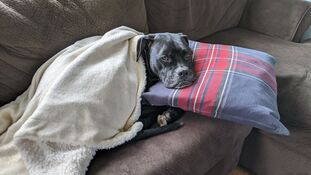Did you take our puppy kindergarten class where we handed you a pair of bunny ears or a silly hat and asked you to wear them for part of class? Maybe you dressed in a parka in July so your pup wouldn't be frightened of the odd looking wear come November. These are great ideas for socialization that we try to cover when our pups are young... but maybe we didn't think about face masks months or years ago. Maybe, like me, you thought your dog was pretty comfortable with new looks until you walked out of the bathroom wearing a charcoal skin mask and your dog barked at you while it dried! Uhoh - why do things like this matter to our dogs? Because we look different! While humans tend to rely more on verbal conversation to communicate, our dogs are constantly reading body language and looking for visual cues to help them understand the world. Now that half of a human face is missing, they have lost some telling body language and that can make them uncomfortable.
We are now living in a world where people are regularly venturing out wearing face masks. So what do we do? Can an old (or older) dog learn new tricks? Yes, they can when we take appropriate steps to help them!
We want to help you get your dog comfortable with face-mask wearing people they might encounter on walks, at the vet's office or even you returning from running errands. We have outlined the steps below to desensitize your dog to people wearing face masks. Some dogs will take to the new look easily and others will be much more concerned by the change. If your dog is struggling, please contact us for help!
It is VITAL that your dog shows no discomfort before you move onto the next step.
Desensitizing your dog to Face Masks:
If you struggle with any of these steps, or your dog is uncomfortable with strangers regardless of their mask, we can absolutely help you virtually!
We are now living in a world where people are regularly venturing out wearing face masks. So what do we do? Can an old (or older) dog learn new tricks? Yes, they can when we take appropriate steps to help them!
We want to help you get your dog comfortable with face-mask wearing people they might encounter on walks, at the vet's office or even you returning from running errands. We have outlined the steps below to desensitize your dog to people wearing face masks. Some dogs will take to the new look easily and others will be much more concerned by the change. If your dog is struggling, please contact us for help!
It is VITAL that your dog shows no discomfort before you move onto the next step.
Desensitizing your dog to Face Masks:
- Show your dog the mask from a distance (start with 6+ feet). Feed a treat, no matter your dog's response. Periodically repeat this step during the day until your dog lights up when you show them the mask! This means he has a great feeling about the mask itself - it means wonderful food is about to come!
- Put the mask on the ground and reward your dog when he checks it out. Do NOT put the mask on your dog!
- Bring out the mask and hold it near your face for a brief moment, then give your dog a treat. If your dog backs up, looks away, or seems uncomfortable at all, you will need to break it down even further - gently move the mask around and treat - repeat until your dog is happy to see the mask moving!
- Begin to put the mask on and treat your dog. If your dog is happy and confident, seemingly unphased, you can leave the mask on and go about your business. Speak gently to your dog while wearing the mask and practice easy cues with him. Please do NOT go for a Darth Vader "Luke, I am your father" voice while chasing your dog!
- Practice with different family members.
- Take it outside! Bring high value treats on all your walks and reward your dog for looking at all the face-masked people you encounter.
If you struggle with any of these steps, or your dog is uncomfortable with strangers regardless of their mask, we can absolutely help you virtually!


 RSS Feed
RSS Feed
